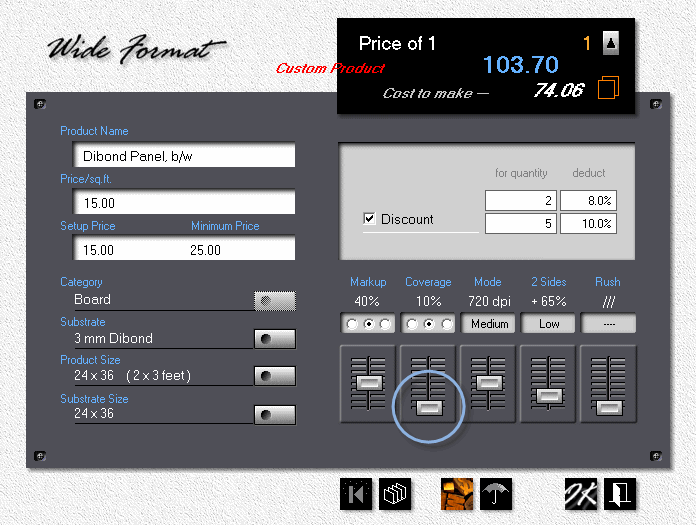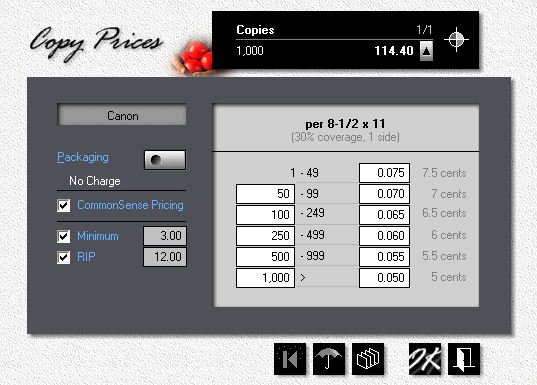Pricing Products
Overview
Before we explore how to price Morning Flight products, let's first define what a product is. Technically speaking, it's a container. Something to hold sheet sizes, makeready, press speed, plate type. A template then, in plain English? Well, sort of, but not exactly. When we think of templates, we see half-finished, fill-in-the-blanks frameworks, with placeholders telling us where to put the missing bits. In contrast, Morning Flight products are completely finished, ready to use as is. They can stand in as models for making other products, and in that case they do act like templates, but generally they're used straight out of the box.
Take a letterhead, for instance. As a template, that letterhead might have its size and plate type hardwired. Makeready and press speed stay open, to be filled in by the estimator. In a Morning Flight product, makeready and press speed are hardwired as well. Everything is. Except we would probably have at least three different letterheads in our product line-up: A standard, run-of-the-mill corporate version, a letterhead with just an address on top, and a demanding prima donna with an exact color match.
The Benefits
Ok, so what can a product do that a template can't? First and foremost, a mockup of the job that needs to be quoted can be compared to some predefined products. Even buyers unfamiliar with printing can match their mockup to one of your samples. Your estimator does his job once, attaching makeready and press speed and other factors when creating each product. Few buyers would have the skills to do that. If you want to sell printing on line at different price levels, you can show pictures that reflect each level.
Along similar lines, cousin Mel can now be entrusted to do most of the low-end quoting, leaving complex and more important projects to a professional estimator. In the smaller shops that's likely to be the owner or manager. Between helping with production and pacifying customers and filling in for employees out with the flu, she's hardly the person who should estimate ten-dollar jobs that rarely materialize anyway. Cousin Mel, on the other hand . . .
Finally, products open the door to automation. Few consumer products are more automated than digital cameras. How automated would those cameras be if they had to work with templates, if exposure and focus had to be dialed in for each picture? With Morning Flight products, parameters are inherent. That allows the program to intelligently increase press speeds as run lengths go up, make sure letterheads don't get printed on card stock, calculate ink consumption based on coverage, keep envelopes from being folded ... the list goes on. Products just generally make life easier.
How do we price Products?
Actually, we don't, not directly. Copy products and wide format are notable exceptions. On offset products, Morning Flight integrates the properties of the product with the hourly rate of the assigned press, reads the quantity, and comes up with a price. On digital products, it's the size and ink coverage of the product that combines with the properties of the press (hourly rate, run speed, click charges, and/or consumables) to determine the outcome. It's a little more complicated than that - a host of other factors get pulled into the mix - but in principal that's how it works.

What separates Wide Format
In a word, technology. And to a lesser extend, the internet. Evolution in this field is so rapid that press-based pricing just isn't practical. What keeps pulling the rug out from under us isn't just the onrush of new inks and hardware, but where and how wide format products are being used. Think fabrics for interior decorating, and contour-cut decals that hardly anyone associates with 'wide'. When you factor in the internet, prices driven by costs go out the window as well. Think Vistaprint.
What's left are value-driven prices based on size, substrate, and what our regional market says they should be. If we can't produce wide format for that, we probably shouldn't be in the wide format business. And if we're planing to sell wide format online, we really do need to look at Vistaprint and other high volume vendors selling banners on the internet. Not to get our prices down to their level necessarily, but to see whether a snazzier banner is the knife we want to bring to the gunfight.
It took nearly a hundred years for print marketing to catch up to how Henry Ford priced the 'Tin Lizzy', his revolutionary model T automobile. In "My Life and Work" published in 1922, he writes:
"We have never considered any costs as fixed. We first reduce the price to the point where we believe more sales will result. Then we go ahead and try to make the prices. We do not bother about the costs. The new price forces the costs down." That's a shining example of value-driven marketing, far beyond giving people what they want. Henry also wrote: "If I had asked people what they wanted, they would have said a faster horse." Ahead of his time, old Henry was.

Why Copies are different
Copies are priced per copy, so here the product alone determines the price. And that's what separates Morning Flight copies from Morning Flight digital. With advances in copier technology, the clear dividing line that once existed between the two methods - toner versus ink - has blurred. Many copiers now serve as digital printers. Today, it's no longer how the image is put on paper, but which pricing model best fits your needs.

See also
